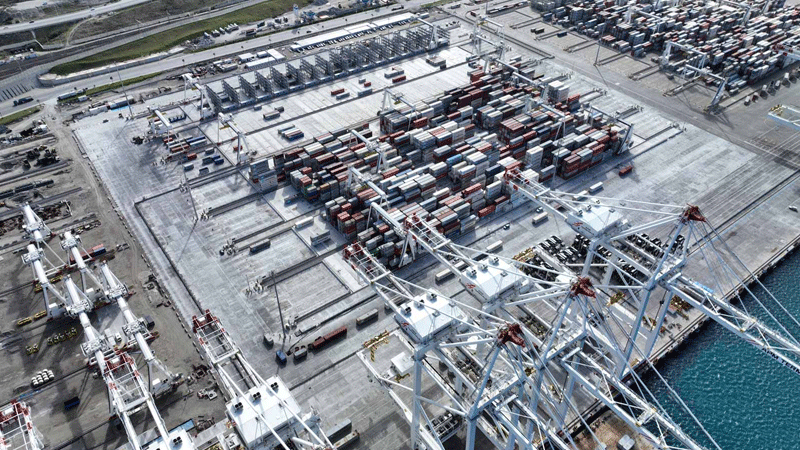An expansion of more than a million TEU (Phase 2) was delivered at APM Terminals Tangier MedPort, Morocco. The expansion covers 18 Hectares, with seven additional container stacks and an additional 400 metre berth. Electric equipment, shore power and auto-mooring will also contribute to APM Terminals industry-leading Net Zero emissions ambition. Phase 3, due in 2025, will increase the total capacity by an additional one million TEU.
This latest expansion will help maintain the semi-automated APM Terminals MedPort Tangier terminals’ reputation as one of the most technologically advanced, efficient and safest container terminals in the world.
New equipment for Phase 2 included 14 electric automated rail mounted gantry cranes and 11 semi-automated hybrid shuttle carriers from Kalmar to support high productivity and further support reduced CO2 emissions.
The four new remote-controlled, ship-to-shore (STS) cranes are among the largest in the world, with an 82-metre outreach. These dual STS cranes can handle cargo vessels of 26 containers in width (or up to 24 000 TEU container capacity). “This will significantly increase the capacity and turnaround efficiency of terminal operations, enabling better service to customers and improving overall customer experience through more efficient operations,” explains Keld Pedersen, Head of APM Terminals West Med Terminals.
The terminal has also installed an innovative auto-mooring system. Automated vacuum pads along the extended part of the quay improve safety and operational efficiency. This will reduce the time taken by vessels to moor and release, with idle times estimated to be reduced to around 15 minutes at both arrival and departure, saving a total of around one hour of idle time.
The system will reduce time spent by tugs in port – reducing emissions – and reduce port stays. According to supplier Cavotec, this results in reduced direct emissions during ship berthing by more than 90% due to the reduced use of tugs and ship engines.
Once ships are moored, active hydraulics significantly reduce vessel motion, thereby positively impacting the terminals’ already exceptional crane moves per hour. APM Terminals MedPort Tangier regularly achieves productivity levels above 34 crane moves per hour on larger vessels. As a result of improved efficiency due to the auto-mooring system, average vessel call times are expected to be further reduced.
Tanger Med Port, where APM Terminals operates two container terminals, ranked fourth in the world’s most efficient ports index, published in June this year by the World Bank and S&P Global Market Intelligence.
Commenting on the terminals ongoing high performance, Pedersen stated: “This year, APM Terminals Tangier (TC1) was also acknowledged as one of the company’s best-performing terminals for the second time in three years. This was based on parameters such as safety, efficiency, customer satisfaction and cost. This investment was needed to ensure we can maintain this as volumes through Morocco increase.”
APM Terminals Tangier MedPort is located at a crossroads between Europe and Africa. Having become a key global player in a relatively short space of time, the Moroccan port and industrial complex has emerged as a strong option for multinationals looking for nearshoring operations.
“International investors are being drawn to Tanger Med’s reputation for efficiency and its links to industry, with more companies also producing in Morocco to serve European and African markets,” explains Pedersen.
Between the third quarter of 2020 and the second quarter of 2022, the deployed capacity of container ships in Morocco increased by 32.5%, mostly driven by the ongoing development of Tanger Med, according to the United Nations Conference on Trade and Development (UNCTAD) Review of Maritime Transport 2022. This outstrips gains made by Panama or Jamaica.
As the terminal prepares to kick off the third phase of expansion, which will cover an additional 17.5 Hectares and add another 400 metre of berth, Project Director, Lionel Expert was rightly proud that, “There was zero impact to customers during the expansion.” Phase 3 of the expansion will be fully operational by 2025.
Together with the port authority, the company is also carrying out the complex infrastructure upgrades to provide shore power. When ships use shore power, they connect to landside electricity for their power needs at berth – lights, pumps, communications, refrigeration – instead of running diesel-fuelled auxiliary on-board engines. According to the US Environmental Protection Agency (EPA), for vessels connected to shore power, under the right conditions, overall pollutant emissions can be reduced by using shore power by up to 98%.
APM Terminals has made an industry-leading global commitment to be fully net zero by 2040. “I’m proud that through this investment, we’re actively making a significant contribution to APM Terminals global targets and at the same time supporting Tanger Meds even tougher 100% zero carbon emissions by 2030,” concludes Pedersen.









